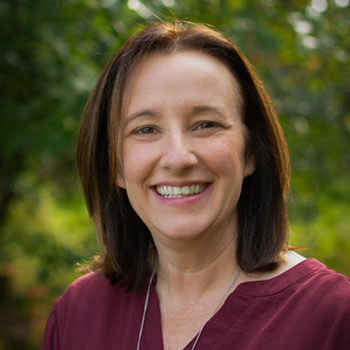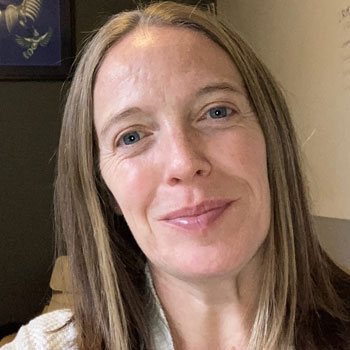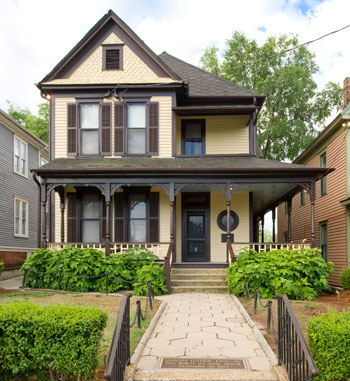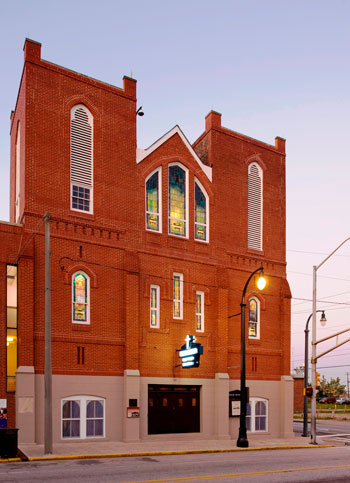Iron Mountain Inc.’s (NYSE: IRM) extensive experience in protecting and managing data and physical assets for businesses across 60 countries makes the REIT not only unique in what it does, but how it approaches corporate philanthropy.
Launched in 2015, its Living Legacy Initiative focuses on preserving, protecting, and making accessible cultural and historical information and artifacts. Think ancient stone drawings, temples from the Qing Dynasty, and famous cathedrals from around the world that are in danger of being lost due to accidental or deliberate destruction.
“When we thought about where Iron Mountain could have the most impact in building a philanthropy program, we said, ‘Where do we really have the opportunity to step in and make a difference?’” says Jennifer Grimaudo, Iron Mountain’s senior director of sustainability.
“Our core business is to preserve and protect really precious assets for our customers,” she says. “Sometimes that's medical records. Sometimes the assets are physical and other times they are digital. But it's really the things that drive businesses. We thought, how can we take that and extend it to our communities?”
At the top of the list of priorities, Grimaudo notes, was preserving cultural heritage globally.
“It's something that connects us all. It’s precious. Could we focus on world hunger?” Grimaudo asks. “Sure. But wouldn't a food and beverage company be better at that? Let’s focus on what we do really well and that’s preserve, protect, and make assets accessible.”
Corporate Responsibility Goes Beyond Writing Checks
Iron Mountain’s Living Legacy Initiative looks to partner with museums and other nonprofits to digitally preserve and make accessible world heritage sites and artifacts that are unknown, at risk, or not widely accessible for future generations to learn and benefit from.
Company officials say finding the right partners is critical to the program’s success.
“It’s finding those integrated partnerships where we can provide more than just financial support,” says Betsy Moyer, Iron Mountain community engagement manager, who leads the Living Legacy program. “It’s us going out and saying, ‘This partnership fits, and how can we work together to make our world a better place?’”
Moyer says Iron Mountain’s expertise and in-kind services multiply the impact of its financial support, because it can provide its partners with physical storage of records and artifacts, digital archives, document scanning, and digitizing old media formats.
“It's a strategic philanthropy program,” Moyer says. “It allows our partners to benefit from our best-in-class services, and Iron Mountain benefits from being able to spotlight its expertise in a very meaningful way.”
CyArk is Integral Partner
Living Legacy has had about three dozen partners over the life of the program. Currently, it has roughly 10 active partners.
Oakland, California-based CyArk, a small nonprofit with a big mission, is its longest-standing and largest partnership.CyArk digitally preserves cultural heritage sites around the world that are being lost due to natural disasters, weather, climate change, population growth, and human conflict. To date, the organization has archived more than 300 sites on all seven continents.
Because of CyArk, Living Legacy was able to expand its reach globally.
“CyArk has been a partner of ours since the beginning of the program,” Moyer says. “When I joined Iron Mountain two years ago, the partnership was clearly one that brought a lot of value to both Iron Mountain and CyArk.’ Since then, we have been able to build on that strong foundation.”
Founded in 2003, CyArk uses laser-scanning technology developed by its founding director Ben Kacyra to record and share the world’s cultural and historic heritage sites in 3D.
Tech entrepreneur Kacyra and his wife Barbara started CyArk because they were worried that the world’s heritage sites, along with the stories they have to tell, are at risk of being lost. The couple created the concept following the Taliban’s destruction of Afghanistan’s 1,600-year-old Bamiyan Buddha statues in 2001.
Today, CyArk maintains a detailed 3D digital archive of the world’s most endangered buildings and heritage sites and shares the models with audiences using virtual reality. CyArk has had more than 2 million virtual visitors.
Iron Mountain Stores CyArk’s ‘Gold’ Copies
Iron Mountain provides data backup and secure preservation services for the “gold" copies of all data from CyArk's digital scans in an underground storage facility, ensuring the critical data is safe.
“One of the things that’s really amazing about our partnership with Iron Mountain is that we've evolved in tandem and grown together,” says Elizabeth Lee, CyArk vice president. “When our relationship with Iron Mountain started, it was because they’re great at protecting these resources, and we’re trying to build this archive. Over the last 10-plus years, the archived piece is still very important, because we want to protect and preserve, but we also want to make it accessible.”
Lee says a big part of CyArk’s work is using the data to solve problems including the conservation and management of these sites. While CyArk itself doesn’t do brick-and-mortar conservation, its data has been used by preservationists for that purpose.
“The other piece is how do we use this information to make these sites and their stories accessible?” Lee continues. “The places themselves, the brick and mortar have meaning but really, they're just a vehicle and a touchstone for these stories. It’s the storytelling piece that really connects us. We want to lift up these stories that people didn't know about and use the 3D data and online experiences as a way to bring these stories to life.”
Digitizing and Preserving the Past
Since 2015, CyArk and Iron Mountain have partnered on the digitization of 20 cultural heritage sites and the creation of 3D virtual tours.
For example, CyArk sent a team to digitally scan hundreds of ancient stone carvings at Rapa Nui at Easter Island in Chile. The digital copies of the 900 carvings, some that are 800 years old, are now preserved and archived.
Other projects include Lukang Longshan Temple in Taiwan; Brandenburg Gate in Berlin; Palacio De Bellas Artes in Mexico; The Royal Exhibition Building in Melbourne, Australia; and the Washington Monument in Washington, D.C. “We worked with CyArk to preserve these sites, help make those stories accessible, and bring them to people's laptops so they can learn from where they are,” Grimaudo says.
Storing Data Underground
Iron Mountain stores data from each of CyArk’s heritage sites in its ultra-high-security storage facility in western Pennsylvania. The vault is located 220 feet below ground in a former limestone mine in Boyers, approximately 65 miles north of Pittsburgh. The 150-acre facility encompasses 1.8 million square feet and is designed to preserve against extreme temperature, humidity, natural disasters, and pests.
The facility operates like a small underground city with its own fire department. It’s protected 24/7 by armed guards and is home to other priceless cultural collections, including the Getty photographic collection of more than 25 million photographic images. There are also original studio recordings of artists like Ozzy Osbourne and original negatives from major motion picture companies. All are stored at optimal temperatures designed to ensure the integrity of the assets.
Collections Around Themes
Iron Mountain decided in 2020 to create specific Living Legacy themes and bring in key partners. The first theme—the “Journey to Equal Rights”—is focused on stories of activism and people and places that sparked lasting change. CyArk was an integral partner in bringing that collection to life.
The two organizations joined forces on a virtual journey to six sites that are pivotal in the struggle of achieving social equity. They include the Women’s Rights National Historical Park, Martin Luther King, Jr. National Historical Park, Stonewall Inn, and César E. Chávez National Monument.
The collection also includes sites that previously had not been documented or preserved, including Angel Island Immigration Station. Located in San Francisco Bay, the station served as an immigration port between 1910 and 1940, when approximately 500,000 immigrants from 80 countries were processed, detained, and/or interrogated at the site.
“We have a really interesting mix of projects, and Iron Mountain has been an amazing partner where we can bring them these sites that maybe they have never heard of, or new ideas to push the boundary, and they have come with us on that journey,” Lee says. That's why this partnership works so well.”
Highlighting Unknown Stories
Grimaudo says she’s most proud when the partnership can take a person, place, or event that was widely unknown and bring that story forward in meaningful ways.
“It’s finding those moments or people in time that have somehow gotten lost, yet they’re so important to our cause,” she says. “We can bring them forward and let the current generations learn from them. It’s unlocking the value of the past to help shape the future, and hopefully, have a better tomorrow as a result of that education.”
Living Legacy's 2023-24 funding cycle is focused on preserving cultural heritage impacted by climate change. CyArk again will be a key partner. The collection will include sites in India, the Brazilian rainforest, and Greenland. “Also, with the support from Iron Mountain, we completed a site in Italy called Civita di Bagnoregio, which is being impacted by erosion and landslides,” Lee says.
The virtual tour investigates Civita Di Bagnoregio’s fragile landscape and highlights the resilience and efforts of the local community to protect the town from climate change and erosion.
“CyArk and Iron Mountain have grown and evolved together over the years, and as a result of that growth and evolution, we've made each other better,” Grimaudo says. “We have gotten better in our programs, and we have been able to bring this global reach and scale to more communities. When corporations find organizations that they can truly partner with, everybody benefits.”




